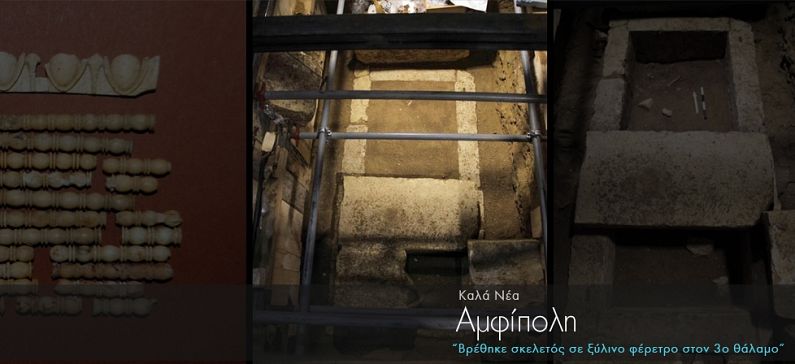
Amphipolis: Skeleton found in wooden coffin in the 3rd chamber
According to the first information from the press conference about the findings in Amphipolis, the archaeological team identified a skeleton, which is almost intact. The skeleton was found in a wooden coffin in a tomb in the third chamber.
At a depth of 1.60m. of the surviving stones of the floor a large cist tomb made of limestone was revealed.
The external dimensions of the tomb are 3,23m length, width 1.56 m and preserved height of 1 m.
Within the tomb was created a longitudinal deepening 0,54m.kai width 2,35m length. This is the position in which the wooden coffin was placed. They also found scaterred iron and copper nails, as well as bone and glass decorative elements of the coffin. It is noted that the total height of the third chamber from the top of the dome to the bottom of the tomb is 8,90m.
In and out of the tomb, they found the skeleton. It is obvious that the anthropological material will be examined by experts.
The burial complex on the hill Castas is a public monument. In order to build it they used the largest amount of marble ever used in Macedonia. Let us remind you of the details of this unique monument: The Tomb height is 33m, and on the tomb is the pedestal of the oversized Leon of 15.84m. The sphinxes, the caryatids and the beautiful mosaic with the abduction of Persephone, and the painted marble architraves, which are maintained in the laboratory of the Museum of Amphipolis. Note the record level of the whole construction.
Therefore, this monument is unique and original synthesis of diverse characteristics. It is an extremely expensive construction, the cost of which is obviously unlikely to have been taken by an individual.
Most probably, this monument is about a hero, a mortal man or woman to whom religious values were attributed by the society of this time. The deceased was a prominent figure.
In the context of the archaeological research in the Tomb, a sampling of sediments inside and outside the tomb was taken, as well as a drilling control to the subsoil, to determine the bedrock. The pellets consist of alternations of sand and marl, lake originated.
For the next few days the sieving of soil will be completed and maintenance of the monument will be continued. The work in the laboratory of the Museum of Amphipolis will continue with particular emphasis on maintenance of the parts of the missing part of the mosaic.
On November 22, the Minister of Culture and Sport Mr. K. Tasoulas will hold a press conference at the Museum of Amphipolis, on the findings and the next phase of work in the Casta tomb.
On November 29, at 11:00 the results of the excavation season at the Casta hill will be presented by K. Peristeri.
Source: Ministry of Culture



















